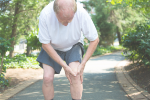One of the more common questions that we answer is around whether you should continue to exercise when you are in pain, or if it is better to stop, rest and let the pain settle. While the advice presented here is not specific – and if you have a healthcare provider looking after you we recommend talking to them about this – we hope that this information helps you to shed some light on what the most appropriate course of action is.
One of the first considerations when deciding if rest is needed, is the onset and the intensity of the pain. If the pain only recently started and there was a specific incident that you can remember associated with it’s onset it is usually better to reduce your activity levels while the area settles. Complete rest is usually only required if there is suspicion of an acute fracture to the area, or if the pain continues to be significantly worse when moving. In all other situations, movement is important to continue, however it is usually reduced in it’s amount, range of movement and load. Where pain has been longstanding, or at least around for 2 or more months, movement is almost always an important part of the management plan. In fact, the longer the pain has been present for, often the more movement is encouraged.
So how much pain is ok and when should you back off? While performing the exercise or movement, we recommend that the pain should be no higher than a 3 out of 10 on a pain scale where 0 is no pain and 10 is the worst pain you could imagine. This is only part of the picture though, as it is also important to monitor your levels of pain for up to 48 hours after you finish exercising. If your pain is related to an irritation of the tendons or ligaments, this is especially important as they often have a delayed pain response. Just like during exercise, the pain levels you experience for the 48 hours after your activity should not elevate beyond a 3-4 out of 10.
Other signs that you should reduce your activity levels include any signs of active inflammation such as redness or swelling after exercise. In addition, if your pain is related to the connective tissues, a significant increase in morning stiffness can indicate that you need to lower your loading. While it should hopefully be very obvious, it is also very important to look at this in conjunction with medication use. If you were taking a medication for pain relief, as you reduce your medication usage you may experience a slight increase in your awareness of your pain.
Of course the area of the body that is affected by pain is also a factor in the decision to keep exercising or to rest. In general, the lower body better tolerates exercising into some mild pain or discomfort better than the arm or shoulder which may need a greater reduction in it’s activity. Postural areas such as the back and neck can be trickier as we often forget how much load they endure from our normal day to day activities.
Finally, a very important deciding factor is your overall level of loading. Your day to day activities or postures may create enough stress that continuing to exercise may result in an overload to the area. It is easy to forget this as we become so accustomed to these activities that we don’t consider that they contribute to our overall load. Often, there needs to be a balance between modifying your normal daily activities and/or postures while also performing some specific exercises.

